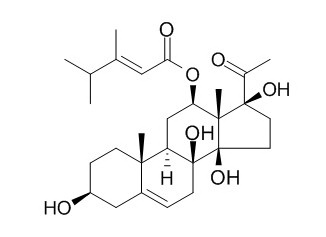Caudatin
Caudatin has anticancer activity, due partly to its inhibition of cell proliferation and induction of apoptosis in cancer cells through caspase activation.It inhibits carcinomic human alveolar basal epithelial cell growth and angiogenesis by targeting GSK3β/β-catenin pathway and suppressing VEGF production. Caudatin exhibits significantly inhibitory activity against HBV DNA replication with IC50 values in the range of 2.82-7.48 μM.
Inquire / Order:
manager@chemfaces.com
Technical Inquiries:
service@chemfaces.com
Tel:
+86-27-84237783
Fax:
+86-27-84254680
Address:
1 Building, No. 83, CheCheng Rd., Wuhan Economic and Technological Development Zone, Wuhan, Hubei 430056, PRC
Providing storage is as stated on the product vial and the vial is kept tightly sealed, the product can be stored for up to
24 months(2-8C).
Wherever possible, you should prepare and use solutions on the same day. However, if you need to make up stock solutions in advance, we recommend that you store the solution as aliquots in tightly sealed vials at -20C. Generally, these will be useable for up to two weeks. Before use, and prior to opening the vial we recommend that you allow your product to equilibrate to room temperature for at least 1 hour.
Need more advice on solubility, usage and handling? Please email to: service@chemfaces.com
The packaging of the product may have turned upside down during transportation, resulting in the natural compounds adhering to the neck or cap of the vial. take the vial out of its packaging and gently shake to let the compounds fall to the bottom of the vial. for liquid products, centrifuge at 200-500 RPM to gather the liquid at the bottom of the vial. try to avoid loss or contamination during handling.
Molecules.2024, 29(5):1048.
Planta Medica International2022, 9(01):e108-e115.
Int J Mol Sci.2023, 24(14):11496.
Molecules.2024, 29(21):5161.
Journal of Herbal Medicine2024, 48:100950
J Ethnopharmacol.2020, 269:113752.
Biochem Biophys Res Commun.2018, 505(1):261-266
J Control Release.2024, 375:300-315.
J Pharm Biomed Anal.2019, 164:119-127
Vojnosanit Pregl2016, 75(00):391-391
Related and Featured Products
Med Chem. 2015;11(2):165-79.
Design, synthesis and biological evaluation of caudatin analogs as potent hepatitis B virus inhibitors.[Pubmed:
25181984]
Thirty-nine Caudatin analogs were designed and synthesized. Their anti-hepatitis B virus (HBV) activities were evaluated in vitro.
METHODS AND RESULTS:
Among them, twenty-three compounds showed much better anti-HBV activity than Caudatin, and eleven compounds significantly inhibited the HBV DNA replication with IC50 values < 10 μM. Interestingly, three compounds (22, 28, 29) exhibited excellent activity against the secretion of HBsAg (IC50 = 63.02 μM, 52.81 μM, 56.08 μM), HBeAg (IC50 = 204.80 μM, 173.51 μM, 70.39 μM), along with HBV DNA replication (IC50 = 24.55 μM, 5.69 μM, 8.23 μM) with lower cytotoxicity. The structure-activity relationships (SARs) of these Caudatin analogs were also discussed.
Oncol Rep. 2013 Dec;30(6):2923-8.
Caudatin inhibits human hepatoma cell growth and metastasis through modulation of the Wnt/β-catenin pathway.[Pubmed:
24064800]
METHODS AND RESULTS:
In the present study, we investigated the antitumor activity of Caudatin in the human hepatoma cell line SMMC‑7721 by analysis of cell viability, cell cycle distribution, apoptosis and metastasis. The results showed that Caudatin impaired the cell viability and inhibited the growth of SMMC-7721 cells in a time- and dose-dependent manner and resulted in cell cycle arrest in the G2 phase. In addition, SMMC-7721 cells, treated with Caudatin exhibited typical characteristics of apoptosis. Furthermore, Caudatin treatment resulted in a decrease in β-catenin and GSK3β in SMMC-7721 cells, with a concomitant reduction in metastatic capability and expression of Wnt signaling pathway targeted genes including cox-2, mmp-2 and mmp-9.
CONCLUSIONS:
Our findings revealed that Caudatin inhibits human hepatoma cell growth and metastasis by targeting the GSK3β/β-catenin pathway and suppressing VEGF production.
J Cell Biochem. 2012 Nov;113(11):3403-10.
Caudatin inhibits carcinomic human alveolar basal epithelial cell growth and angiogenesis through modulating GSK3β/β-catenin pathway.[Pubmed:
22678744]
METHODS AND RESULTS:
In this study, we investigate the anti-cancer activity of Caudatin in carcinomic human alveolar basal epithelial cell line A549 and anti-angiogenic activity in human umbilical vein endothelial cells (HUVECs). We show that Caudatin impairs the cell viability and induces G(0) /G(1) phase arrest in A549 cells with a dose dependent manner. A549 cells, not HUVECs, dealing with Caudatin exhibited typical characteristics of apoptosis, which were accompanied by activation of caspase-3, caspase-9 and Poly(ADP-Ribose) Polymerase (PARP). In addition, Caudatin treatment resulted in a decrease of β-catenin and increase of phosphorylation of β-catenin, and inhibited phosphorylation levels of GSK3β (Ser 9) in A549 cells. Conditional medium of A549 cells-induced or growth factors-induced tube formation of HUVECs was markedly inhibited by Caudatin treatment, which was associated with the inhibiting VEGF secretion from A549 cells by Caudatin.
CONCLUSIONS:
Our findings suggest that Caudatin inhibits carcinomic human alveolar basal epithelial cell growth and angiogenesis by targeting GSK3β/β-catenin pathway and suppressing VEGF production.



